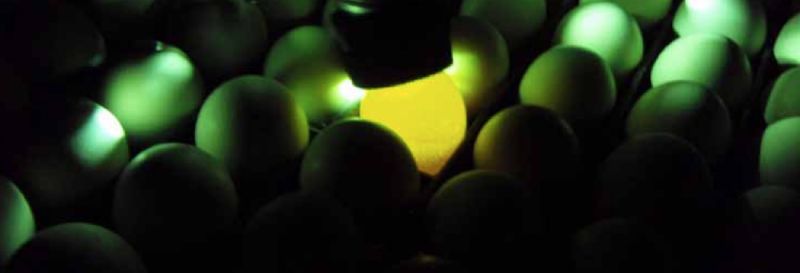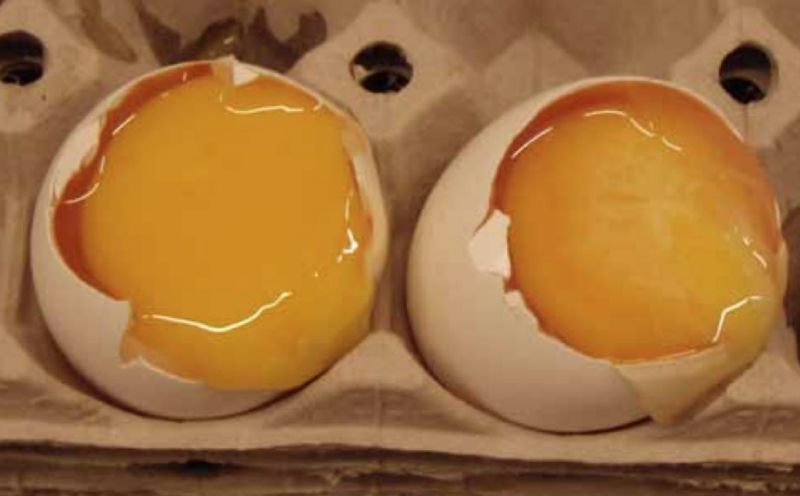Key factors for successful hatching egg handling
To preserve hatchability from egg deposition till setting is the aim with hatching eggs. Temperature and hygiene are the two key parameters for a successful hatching egg handling.
A hatching egg is not like any other egg. A hatching egg contains the complete genetic potential, which has been achieved by LOHMANN TIERZUCHT during decades of continuous breeding work. This potential is embedded in a little embryo on the egg yolk. When managing hatching eggs, the aim is to retain the quality of the hatching eggs from the moment of egg deposition till setting in such a way, that the embryo has optimum developing conditions and that after 21 days vital chicks can hatch.
The quality of the freshly laid hatching eggs is among others influenced by the following factors:
• Health status and uniformity of parent stock
• Feed quality
• Water quality
• Management system
• House climate
• Number and quality of males
These factors influence the shell quality, the egg size, the nutrients and the maternal antibodies in the hatching egg. Furthermore, they define the fertilisation rate and the germ load of the laid eggs.
After egg deposition, a successful management of the hatching eggs maintains the hatchability of the eggs till setting. For this, the important factors are:
• Type and cleanliness of the nests
• House temperature
• Frequency and care of egg collecting and transport
• Egg storage temperature
• Disinfection of egg shells.

These criteria can be reduced to two key parameters: hygiene and temperature. Why are these two parameters so important?
Clean nests indispensable for hygiene of hatching eggs
Naturally, a hatching egg is relatively well protected against the penetration of bacteria as long as egg shell and cuticle are intact. If these barriers are damaged, for example caused by careless handling of the hatching eggs, badly adjusted conveyor belts etc., bacteria can easily penetrate the egg. This can lead to embryo mortality and to an overall reduced quality of the chicks due to contaminated eggs (so called bangers).
Shortly after egg deposition is a particular critical moment, the egg shell is moist and the cuticle is not yet an effective protection. In addition, during this period the egg is cooling down from the hen’s body temperature (41°C) to house temperature. Due to this process of cooling down, the content of the egg contracts and a vacuum is created in the egg. In compensation, air enters and forms the air cell. Together with this air, bacteria can easily penetrate the egg. For this reason, it is very important that only hatching eggs are used which have been laid in a clean nest.
Caution with floor eggs
Floor eggs or system eggs are most probably already contaminated before they can be collected, disinfected or washed if necessary. Thus, they should not be set in the incubator. Also on clean hatching eggs an inevitable number of bacteria can be found. In order to reduce them, the eggs should be disinfected very quickly after collecting. In the past, fumigation with formaldehyde was often used as the standard procedure. Besides the undisputable effectiveness of this fumigant, it also has several disadvantages. These include embryo damage, particularly if the dosage or the temperature is too high or if the fumigation time is too long. Furthermore, formaldehyde is classified as potentially carcinogenic (cancer-causing).
Nowadays, a lot of less harmful chemicals are available, which are at least as effective as formaldehyde for disinfecting egg shells. In many hatcheries fogging of the disinfectant with a very small droplet size has become the prevalent process. It ensures a good contact of the agents to the egg surface without making it really wet. The Technical Service of LOHMANN TIERZUCHT is at disposal for information on products, which have been proven to work.
Ill. 2: Fogging of disinfectant for bacteria reduction on the egg shel



Ill. 3: Candling with hand lamp
Aiming at an adapted egg storage temperature
Temperature is the crucial parameter for storing eggs. Here, the principle applies that the longer the hatching eggs have to be stored the lower the optimum temperature. What is the reason for that?
After egg deposition, first the embryonic development has to be interrupted. This requires cooling down the egg within six hours below 26-27°C. Normally, this happens in the nest or on the egg belt. If during summer the outside temperature is high, the eggs cannot cool down sufficiently in the house. Under those conditions, the hatching eggs should be collected more frequently and transferred to a cooled store. This avoids exposing the embryos for too long a time to a temperature of 27-37°C. Temperatures within this range cause an imbalanced development of the embryo and thus, lead to a higher rate of early embryonic mortality (Ill. 4).
After the cell division has been stopped due to the cooling down of the eggs below the physiological zero, the hatching eggs must slowly be cooled down to an even lower temperature. Thus, the quality of the albumen is stabilized, the water loss is reduced and the mortality of embryonic cells is minimised.
If the eggs are stored only three to four days, they must not be cooled down below 20°C. A relatively high storing temperature fosters the dilution of the albumen and thus, the gas exchange during the first days of incubation. However, in most layer hatcheries hatching eggs are stored up to ten days. In this case, a temperature of 16-18°C is recommended (Ill. 1).
Even temperature for all eggs
It is important that the targeted storage temperature is preferably achieved for all eggs and that it stays nearly constant. Large variations should be avoided, because they can also contribute to a higher rate of early embryonic mortality. For this reason, special attention should be paid to good insulation and sufficient cooling capacity of the egg rooms in order to compensate for daily variations in the outside temperature. For temperature control the regular use of temperature loggers is recommended. They can be placed in the egg room or they can be used during egg transport from the parent stock farm to the hatchery.
Ill. 4: Two opened candled eggs: unfertilized (left) and early died embryo (right)











